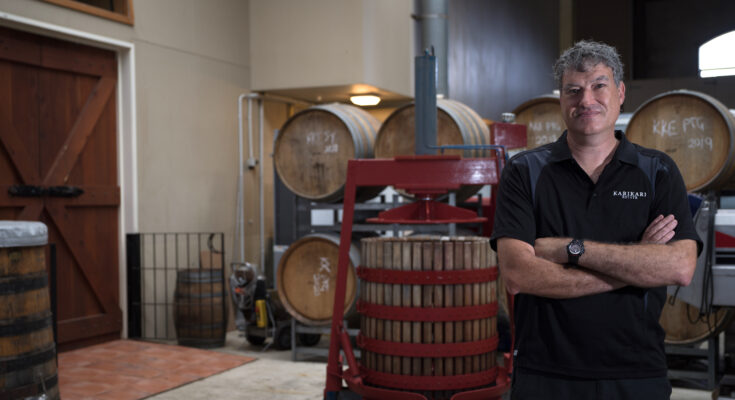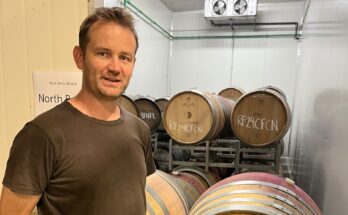I was in the north, looking at some of the smaller producers in the region, and thought I’d take the opportunity to drive up to New Zealand’s most northerly vineyard – and what a sensational vista awaits visitors to the cellar door of Karikari Estate. It’s spectacular. A coastal location, perched high on a ridge, with epic views over the vines to the sea. I meet up with winemaker Alan Collinson to see what’s been happening up at the top of the island.
Alan Collinson: I’m originally from around here – Kaitaia, and went to Auckland when I finished school for a couple of years in Business Studies. Then came back up here to work on my parents’ farm in the summer of ‘98. I ended up working in the local Okahu Estate vineyard. I was supposed to be there for a few weeks, but they got me into the winery and helped with the harvest. Then said they were looking for someone to help out for a couple of months – in particular to keep the Cellar Door open for the winter, but there’s not really enough work in there full time, so do some winery work as well.
I didn’t know a thing about wine. I didn’t even actually like the taste of wine. They said don’t try and open too many samples, because you’ll not get too many people and there would be wastage. Just talk about it and do your best to sell it. If you think there’s someone keen, then open the bottles, but not too many! People would always ask me what I liked, and I’d be clear that I wasn’t really into wine, but that I’d been told the best wine here was the Cab/Shiraz for $50. The owner had a look at the sales at the end of the month… Cab/Shiraz, Cab/Shiraz, Cab/Shiraz – how did you sell all these ones? He said he always sold the cheaper ones and not many people would buy the expensive one! So he said he’s keep me on, and it just went from there.
I picked up a bit more each year. Did a correspondence course in winemaking from EIT for three years. The rest of it is just learning on the job – tasting and so on. Joined the Northland Winegrowers and started getting to all the local vineyards and doing tastings with that. You’ve been to a few I see?
WF: Yeah, a few. Rod at Marsden has definitely made it his intention that I know about Northland. I came up to have a look a while back in November and went to a few places. Rod told me where was good to go and told me about you guys but that it was a bit further away, so I left that for this trip instead. I was there this morning and did like a Regional Tasting, and had some stuff out of the barrels and tanks.
I’d met Kim at Winetopia as well and said that I would drop in next time I was up this way, so called in at Dancing Petrel. It’s going to be a long day. But that’s OK because I want to come to all these places. It’s all very well being sent wines and emailing people, but nothing is the same as actually coming and seeing the place where the wine is grown. And it’s a lovely day.
AC: Well, Karikari means ‘windy, windy’ so we always get a bit of a breeze coming through. You’ve got Puheke out here – that means ‘octopus’ and you’ll see that on our label; and the North Cape is straight out at the tip there – it’s a fantastic view. We’re part of the Carrington group, and people sometimes get confused when they see Carrington Estate as well as Karikari estate – but we’re all the same. The Carrington Group own about 2500 acres from the wetlands at the bottom of the hill, and then half the hill up to here, with 13 hectares planted as vines. I think there’s about 40 hectares in plantable land been mapped out. We’re looking to plant about another 3 hectares this year. Some more Syrah and Chardonnay, and Pinot Gris for the first time. Those are the three most common varietals for Northland.
WF: I also like the weird and wonderfuls that you see up here – the Chambourcin, Pinotage and Flora. You’d think that they might just be a kind of novelty , as something unique, and possibly so because they’re not very good. But they are good.
AC: I think Northland has quite a diverse climate so we’re able to grow a few more varietals. When you look at where we are, and it was the second week in February when we harvested our Pinotage this year. Pretty early. I went down to the Northland Growers meeting at the end of January, and our Pinotage is all coloured up and pretty much ready to pick, and you go into Marsden estate and its still green and hard. We actually did really well this year because of the wind effects. In November there were some really hot nights – it was 24 degrees at night. And it was humid but with that bit of breeze it kept the downy mildew away.
WF: How has that wind affected the vineyard – have the vines had to adapt in some ways?
AC: We have much smaller leaves on the vines because they’ve naturally adapted to the climate and trying not to lose all the water. We also don’t have to do much leaf plucking. If we take leaves off they don’t generally grow back! You’ve got to be careful you don’t go too far.
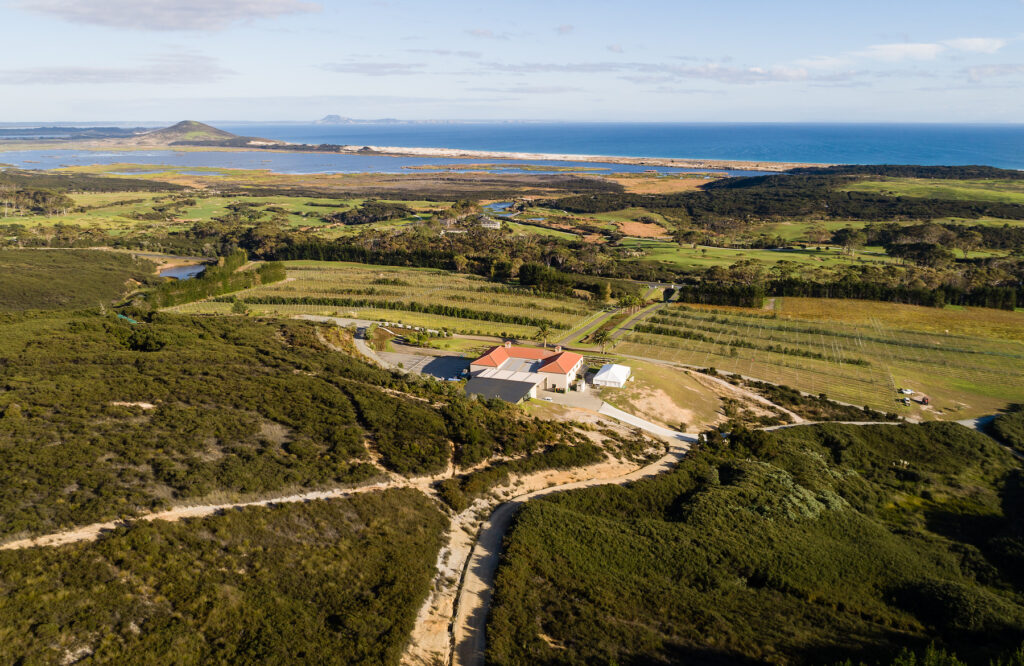
With our chardonnay it’s about getting more bunches on the vine. You can walk through the vineyard and there will be a really nice patch with twenty to thirty bunches, and beside it will be one with one bunch on it. I put it down to soils and variations and exposure levels. Tannat does reasonably well here, but Tannat and Syrah dry off quite quickly, so they’re not so drought resistant.
WF: What do you do with your Tannat?
AC: Has been blended in the past. We’ve got some nice 2019 in barrel so we’re looking at doing a stand alone wine with that. The 2018 was really good too, but was needed for the blend, as it was a poor year generally for our reds here. Every one lacked colour and flavour except the Tannat, which had really good tannins too. We usually get really good tannins from our grapes. That’s what the tannat was originally planted for, to help build structure to the reds.
WF: It’s a pretty unusual variety to find. We’re not in Uruguay. It’s another one to add to the list of wines you don’t see every day.
AC: There’s a lot of people who come here who don’t know about Pinotage as well.
WF: It’s funny in Europe. There’s definitely an open mind to lots of things that I don’t think you’re exposed to here. With all the producers from Europe right there you can get fantastic European wines obviously, including places like Greece, Hungary, Croatia – not just the usual. But also things like South African, or South American. Funnily enough, not much American, but I suppose that’s because you’d think “why would I drink expensive Californian wine, when good French or Italian wine is so affordable and accessible here?” And down here – you go to Australia for example, and they’re utterly convinced that their wine is the best in the world. And if you say you’re from New Zealand, they say “oh well, never mind, at least you’ve got Sauvignon Blanc”. You have to try wider than just what you know or what’s on your doorstep.
AC: It’s what you get used to. And like they were saying with the climate change, the Sauvignon Blanc is probably going to start changing flavours soon. New Zealand has cornered that market for that style, but if you go to Hawke’s Bay for example, the first thing they say is “this is not a Marlborough Sav”. However, it sounds a bit like they’re putting themselves down a bit by saying that.
WF: And what do think of natural wines? I’ve seen quite a few of those that are Sauvignon Blanc based?
AC: I’m not a fan of them myself. Everyone’s got their own tastes I guess, and you’ve got all these different markets. I was talking to Cameron Douglas and he was talking about Chambourcin and he was at a judging and scored it 95 points. When they came together there were scores like 70, 75, and he asked why it had scored so low. And people said ‘it’s a bit funky’ and he said, “Well isn’t that the point, it’s part of its natural character – shouldn’t we be judging it on whether its true to that?”
WF: And it’s one wine that I guess is known for Brett, and I think that if it’s not overpowering, that it adds to the character of Chambourcin as well. I’m all about wines with character and personality, and it’s a varietal that has that in spades. You look at the ‘modern chardonnay’ with bags of reductive character, and they won all the awards in Chardonnay classes at Shows the world over – and that was considered a fault in the past. Now it ‘adds complexity’ – which I agree with, in moderation. I’m not a winemaker and I tend to look at wines from a consumer view – would the man on the street like this wine?
AC: When I was at Okahu we made some Chambourcin, and around 2003 we had a few cases left. It had become full of Brett, but with the wine really full and rich as well.
Getting past the nose was a bit hard for some people. So the new vintage comes along and it was fresher and some people would buy that – then come back and say ‘I preferred the 2003, do you have any of that left!’
WF: Rod pulled out a Marsden Estate Pinotage from 2004 this morning – beautiful. It had written on the back label “Cellar for 2-3 years” Whoops.
AC: Pinotage can age really well.
We go try some wines – from the barrels first
AC: This is where it all happens! Originally they were looking to do about 200 tonnes through here, so it’s set up for bigger volumes with quite big tanks. I think the most they’ve ever got was about 60 tonnes, so I think the calculations were a little bit out. I think whoever they were getting their figures from were based in Marlborough at 12 tonnes per hectare, and with vines planted closer together. If you look at us we’re 3 metre spacings, so every fourth row you’re losing a row of grapes. This was set up in 2004.
This is 2020 Chardonnay. We’ll probably look at bottling this in another couple of months or so. I try to push it off for as long as I can, until I think it’s ready. We usually age it for about 18 months before we bottle it.
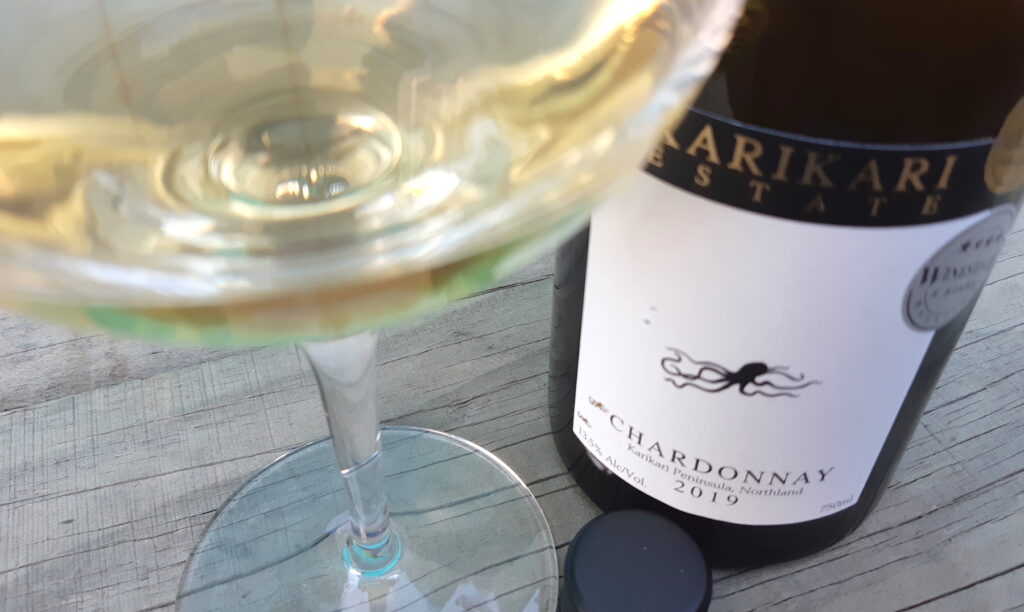
About 50% new oak. A couple of French barrels and some American oak too, and a portion in tank. We were lacking a little bit of sweetness – had some comments that the wine was a little dry. We aim for a style that’s soft and generous. Just looking at finishing putting this years wine in barrel and then we’ll start on the blends and getting this ready.
And this is our Syrah – this has been doing really well over the last three years. It’s got nice spicy but soft flavours. I might have to bottle this quite soon!
WF: Yes, that has got a lovely spice to it. I sometimes think that although New Zealand Syrah has that lovely floral edge, and plenty of bright fruit purity, that it sometimes is lacking in that peppery edge that I think consumers are looking for in a Syrah. Maybe because they’re more accustomed to Shiraz?
AC: We were down in Hawke’s Bay a few weeks ago and went around the Gimblett Gravels area. I quite like the Cabernet from there. I bought ‘The Gimblett’ from Trinity Hill, and their Gimblett Gravels Syrah.
WF: They have a lot of collaboration down in Hawke’s Bay, I guess it’s a fairly tight community. Do you feel a bit out on your own up here?
AC: We get together with the Northland Winegrowers and have a bit of a tasting, and we get some tastings from the barrel reps who come round. In fact, I bought a barrel for Chardonnay and then ended up using it for the Pinotage you’ve got there! It tasted alright!
WF: Big tannins in this, but I like it. Chewy and quite tasty – goes well with the fruit and doesn’t look out of place. It works. It’s actually got quite a nice smokiness, lovely sweet fruit, but then that fades off and the finish is fairly delicate, for such a robust kind of wine.
AC: You’ll fancy a taste of the Tannat?
WF: Absolutely I will! Can I just say, as well, that I love barrel halls! Even my wife, if she comes out with me on very rare occasions, she loves the smell of the barrel hall.
AC: It’s beautiful. This is the 2019 Tannat.
WF: Oof that grabs you! Crikey. I think that needs a bit of settling down still. It’s got great fruit but it really sucks your cheeks in, that tannin. Powerful stuff.
We go through to the Cellar Door and try some ‘finished’ wines from the bottle. I’m keen to try the 2019 Chardonnay (I know).
AC: That was eighteen months in the barrel.
WF: Hmmm. I like it, but I’m not sure it’s quite decided what it’s going to be yet. There’s some edginess that I’m not sure about. It’s got quite a bit going on, and it’s not horrible by any means. I wonder if it would open up a bit, with a bit of air in it – I’d probably decant that and have a longer look at it. It’s not bad but I think it’s on the edge of being a lot better. It’s not a shouty Chardonnay and I like that restraint, but I think I expected a bit more power? I do like a bit of intrigue in a wine though – keeps you interested rather than just one glass and it’s all over.
AC: We’re still under cork for the Karikari range Syrah. Chardonnay, Syrah and Pinotage are our top three wines.
WF: I don’t know if you saw my Top 10 Tasting report on Syrah, but I’d say there were quite a few corks – three of the top 10 I think, and there were several more.
OK, this Syrah has some synergy from what I tasted in the barrel to this final product. That’s lovely – spicy, blue fruits, and it’s got that tang that we talked about before – an iron, minerality. I like that it’s not too soft – for this one, that’s a good thing. It stays structured and serious right through, just keeps marching on. Good finish!
AC: I’d say we’re one of the few vineyards that had a fantastic 2017. We had a wet spring but then a dryish summer. In February it poured down with rain, but we were pretty much ripe and it had been dry so it just sucked into the ground straightaway. We were just at the right, ripe stage. But in Kerikeri they’re usually a couple of weeks behind. Up here you get to Mid-March and there’s not much more ripening happens.
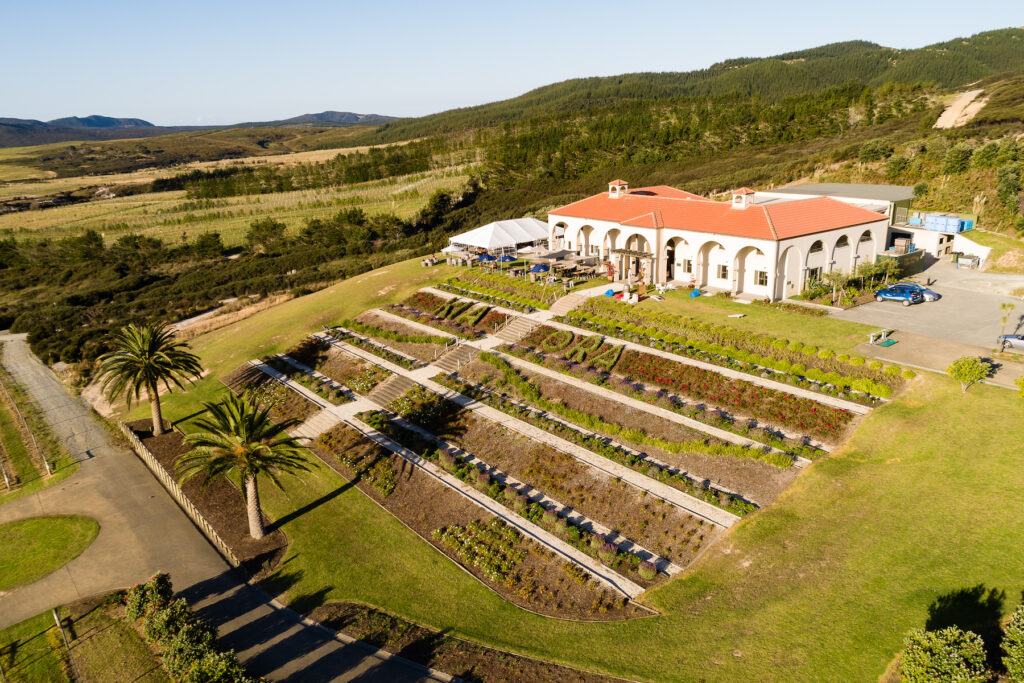
WF: do you have a personal favourite wine, outside of what you make here? If someone gave you the money for a bottle of wine in a shop, what would you walk out with?
AC: I actually really like Syrah, so probably a red.
WF: And what do you think of something like White Diamond? How is that suddenly worth hundreds of dollars, when it used to be a normal price? Is it just spin, and marketing, to say it’s now worth $500?
AC: It’s just getting it out there. They were at Winetopia last time. To me it’s like getting a bunch of grapes and stuffing them in your mouth and chewing on it. Just full-on, intense flavours, but not really like a wine at all.
We’ve been to Winetopia a few times and I noticed that there’s lots of Pinot around, so everyone was on those – a few light ones there and a few heavier ones. And the they come along to the Pinotage and they’re like “oh this is totally different” but then they come back around and tell us they think it’s the best wine they’ve had at the Show! We just tell them to put their name on the mailing list!

